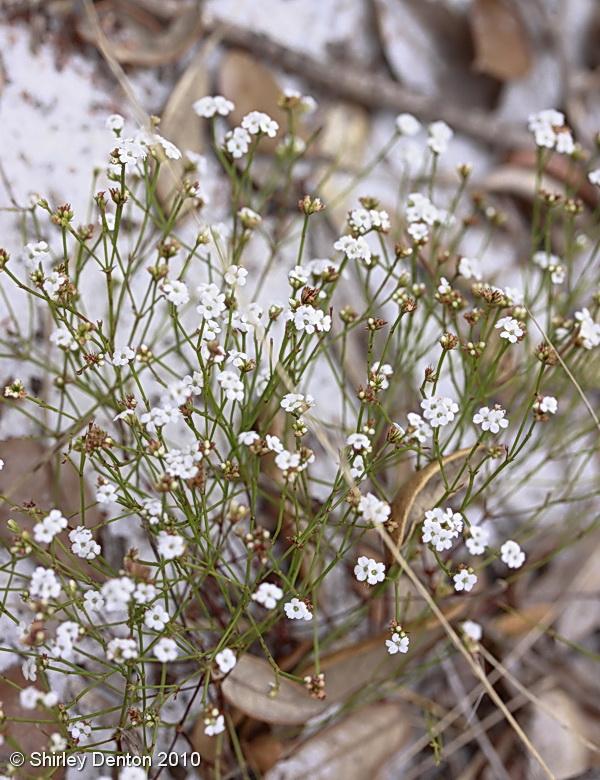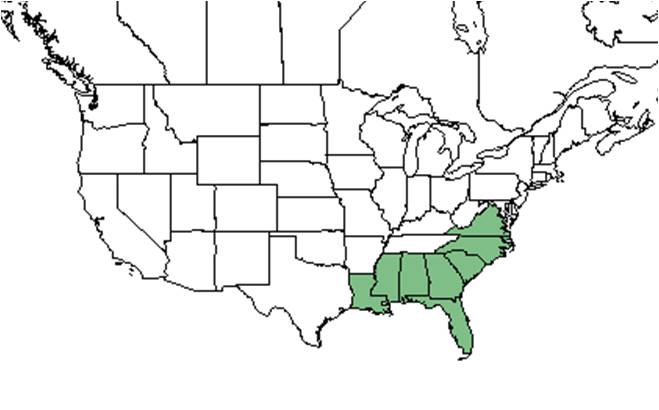Difference between revisions of "Stipulicida setacea"
(→Photo Gallery) |
KatieMccoy (talk | contribs) (→Taxonomic notes) |
||
| Line 20: | Line 20: | ||
Common name: pineland scalypink | Common name: pineland scalypink | ||
==Taxonomic notes== | ==Taxonomic notes== | ||
| + | The genus name ''Stipulicida'' derives from the Greek meaning for fibers. The specific epithet ''setacea'' comes from the Latin word for bristle- which refers to the tiny leaves that resemble bristles<ref name="alabama">[[http://alabamaplants.com/Whiteopp/Stipulicida_setacea_page.html]]Alabama Plants. Accessed: March 17, 2016</ref>. | ||
| + | |||
==Description== | ==Description== | ||
<!-- Basic life history facts such as annual/perrenial, monoecious/dioecious, root morphology, seed type, etc. --> | <!-- Basic life history facts such as annual/perrenial, monoecious/dioecious, root morphology, seed type, etc. --> | ||
Revision as of 08:48, 18 March 2016
| Stipulicida setacea | |
|---|---|

| |
| Photo by Shirley Denton (Copyrighted, use by photographer’s permission only), Nature Photography by Shirley Denton | |
| Scientific classification | |
| Kingdom: | Plantae |
| Division: | Magnoliophyta - Flowering plants |
| Class: | Magnoliopsida – Dicotyledons |
| Order: | Caryophyllales |
| Family: | Caryophyllaceae |
| Genus: | Stipulicida |
| Species: | S. setacea |
| Binomial name | |
| Stipulicida setacea Michx. | |

| |
| Natural range of Stipulicida setacea from USDA NRCS Plants Database. | |
Common name: pineland scalypink
Contents
Taxonomic notes
The genus name Stipulicida derives from the Greek meaning for fibers. The specific epithet setacea comes from the Latin word for bristle- which refers to the tiny leaves that resemble bristles[1].
Description
A description of Stipulicida setacea is provided in The Flora of North America.
S. setacea has white flowers, usually in clusters of three; with five petals, three stamen, and three lobed ovaries (FSU Herbarium).
Distribution
Ecology
Habitat
In the Coastal Plain, S. setacea has occurred in shrubless barrens, sandhill clearings in oak woodlands, sand pine-oak scrubs, longleaf pine-saw palmetto flatwoods, edge of cypress wetlands, oak-hickory hammock forests, open oak-hickory-sand pine scrubs, an open slash pine woodland bordering a tidal marsh, and Quercus geminata woods. It has been found in disturbed areas such as powerline corridors, grassy roadsides, sandy old fields, parking areas, moist banks of drainage canals, and a pineapple field (FSU Herbarium). Soil types include loamy sand, sand, and sandy peat (FSU Herbarium). Associated species include Lupinus diffusus, Arenaria caroliniana, Opuntia, Parnoychia erecta, Polygonella robusta, Helianthemum, Vaccinium, and Crataegus (FSU Herbarium).
Phenology
Flowers March through June and fruits May through August (FSU Herbarium).
Seed dispersal
Seed bank and germination
Fire ecology
Stipulicida setacea has been observed growing in burned pinewoods (FSU Herbarium).
Pollination
The following Hymenoptera families and species were observed visiting flowers of Stipulicida setacea at Archbold Biological Station (Deyrup 2015):
Halictidae: Lasioglossum nymphalis
Megachilidae: Anthidiellum notatum rufomaculatum
Vespidae: Leptochilus krombeini, Microdynerus monolobus
Use by animals
Diseases and parasites
Conservation and Management
Cultivation and restoration
Photo Gallery
References and notes
Deyrup, M.A. and N.D. 2015. Database of observations of Hymenoptera visitations to flowers of plants on Archbold Biological Station, Florida, USA.
Florida State University Robert K. Godfrey Herbarium database. URL: http://herbarium.bio.fsu.edu. Last accessed: November 2015. Collectors: Loran C. Anderson, Wilson Baker, Leonard J. Brass, James Buckner, Delzie Demaree, R.B. Channel, George R. Cooley, A.H. Curtiss, Wilbur H. Duncan, Bob Fewster, Angus Gholson, Robert K. Godfrey, H.A. Hespenheide, Edwin Keppner, Brian R. Keener, Robert Kral, S.W. Leonard, Sidney McDaniel, Marc Minno, John B. Nelson, Elmer C. Prichard, A.E. Radford, Paul Redfearn, William Reese, Annie Schmidt, Robert Simons, Cecil R. Slaughter, John K. Small, Wayne K. Webb, R.L. Wilbur, Kenneth A. Wilson, Carroll E. Wood Jr.. States and Counties: Alabama: Autauga, Baldwin, Henry Florida: Bay, Calhoun, Escambia, Flagler, Franklin, Gadsden, Highlands, Hillsborough, Holmes, Indian River, Lee, Leon, Levy, Liberty, Marion, Martin, Osceola, Palm Beach, Polk, St. Lucie, St. Johns, Volusia, Wakulla,Walton, Washington
Georgia: Ben Hill, Laurens, McDuffie, Richmond, Wheeler. Mississippi: Jackson. North Carolina: Bladen, Craven, Moore, Robeson. South Carolina: Lexington, Richland. Compiled by Tall Timbers Research Station and Land Conservancy.